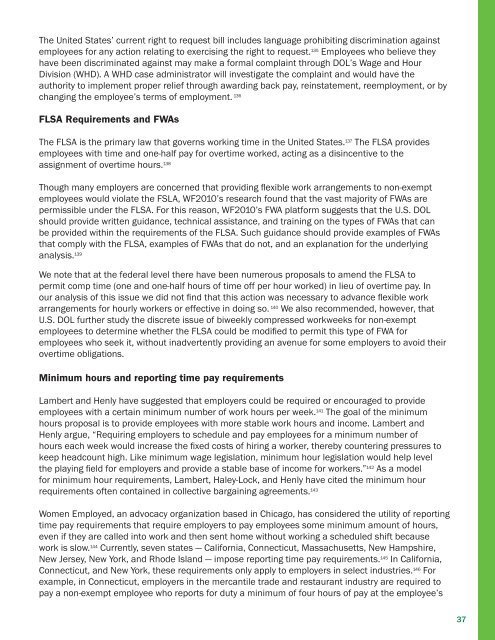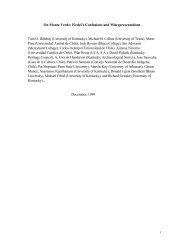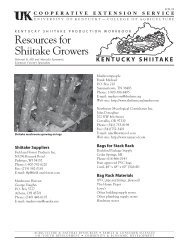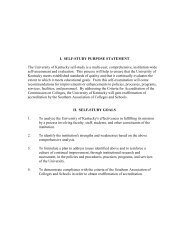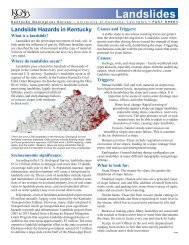Flexible Workplace Solutions for Low-Wage Hourly Workers
Flexible Workplace Solutions for Low-Wage Hourly Workers
Flexible Workplace Solutions for Low-Wage Hourly Workers
You also want an ePaper? Increase the reach of your titles
YUMPU automatically turns print PDFs into web optimized ePapers that Google loves.
The United States’ current right to request bill includes language prohibiting discrimination against<br />
employees <strong>for</strong> any action relating to exercising the right to request. 135 Employees who believe they<br />
have been discriminated against may make a <strong>for</strong>mal complaint through DOL’s <strong>Wage</strong> and Hour<br />
Division (WHD). A WHD case administrator will investigate the complaint and would have the<br />
authority to implement proper relief through awarding back pay, reinstatement, reemployment, or by<br />
changing the employee’s terms of employment. 136<br />
FLSA Requirements and FWAs<br />
The FLSA is the primary law that governs working time in the United States. 137 The FLSA provides<br />
employees with time and one-half pay <strong>for</strong> overtime worked, acting as a disincentive to the<br />
assignment of overtime hours. 138<br />
Though many employers are concerned that providing fl exible work arrangements to non-exempt<br />
employees would violate the FSLA, WF2010’s research found that the vast majority of FWAs are<br />
permissible under the FLSA. For this reason, WF2010’s FWA plat<strong>for</strong>m suggests that the U.S. DOL<br />
should provide written guidance, technical assistance, and training on the types of FWAs that can<br />
be provided within the requirements of the FLSA. Such guidance should provide examples of FWAs<br />
that comply with the FLSA, examples of FWAs that do not, and an explanation <strong>for</strong> the underlying<br />
analysis. 139<br />
We note that at the federal level there have been numerous proposals to amend the FLSA to<br />
permit comp time (one and one-half hours of time off per hour worked) in lieu of overtime pay. In<br />
our analysis of this issue we did not fi nd that this action was necessary to advance fl exible work<br />
arrangements <strong>for</strong> hourly workers or effective in doing so. 140 We also recommended, however, that<br />
U.S. DOL further study the discrete issue of biweekly compressed workweeks <strong>for</strong> non-exempt<br />
employees to determine whether the FLSA could be modifi ed to permit this type of FWA <strong>for</strong><br />
employees who seek it, without inadvertently providing an avenue <strong>for</strong> some employers to avoid their<br />
overtime obligations.<br />
Minimum hours and reporting time pay requirements<br />
Lambert and Henly have suggested that employers could be required or encouraged to provide<br />
employees with a certain minimum number of work hours per week. 141 The goal of the minimum<br />
hours proposal is to provide employees with more stable work hours and income. Lambert and<br />
Henly argue, “Requiring employers to schedule and pay employees <strong>for</strong> a minimum number of<br />
hours each week would increase the fi xed costs of hiring a worker, thereby countering pressures to<br />
keep headcount high. Like minimum wage legislation, minimum hour legislation would help level<br />
the playing fi eld <strong>for</strong> employers and provide a stable base of income <strong>for</strong> workers.” 142 As a model<br />
<strong>for</strong> minimum hour requirements, Lambert, Haley-Lock, and Henly have cited the minimum hour<br />
requirements often contained in collective bargaining agreements. 143<br />
Women Employed, an advocacy organization based in Chicago, has considered the utility of reporting<br />
time pay requirements that require employers to pay employees some minimum amount of hours,<br />
even if they are called into work and then sent home without working a scheduled shift because<br />
work is slow. 144 Currently, seven states — Cali<strong>for</strong>nia, Connecticut, Massachusetts, New Hampshire,<br />
New Jersey, New York, and Rhode Island — impose reporting time pay requirements. 145 In Cali<strong>for</strong>nia,<br />
Connecticut, and New York, these requirements only apply to employers in select industries. 146 For<br />
example, in Connecticut, employers in the mercantile trade and restaurant industry are required to<br />
pay a non-exempt employee who reports <strong>for</strong> duty a minimum of four hours of pay at the employee’s<br />
37


